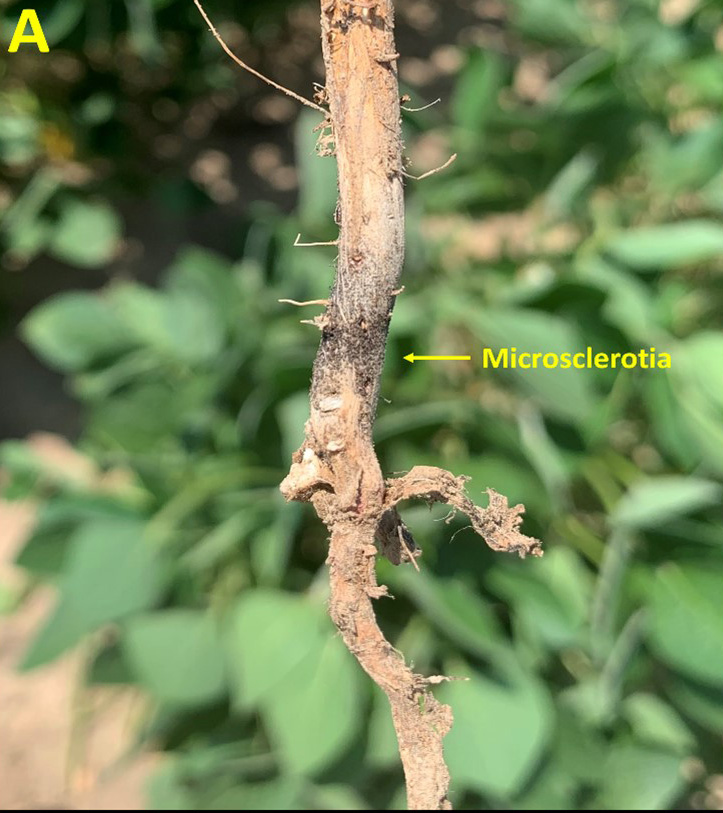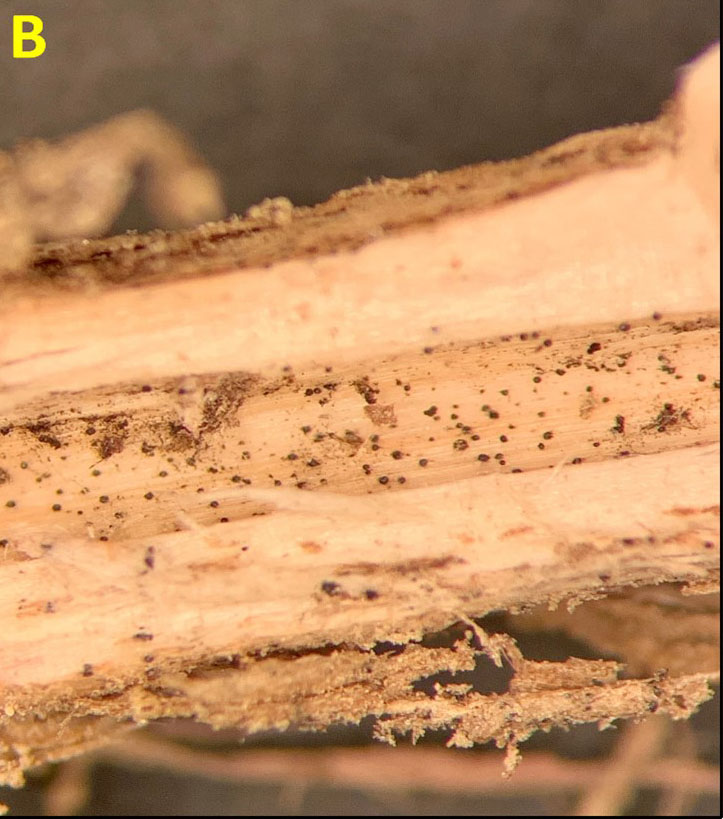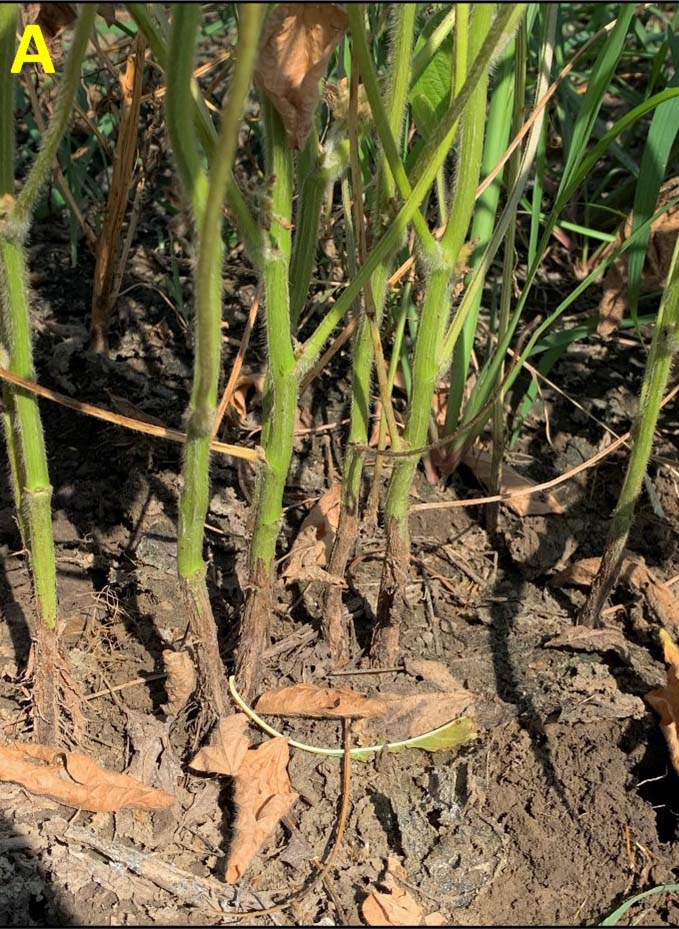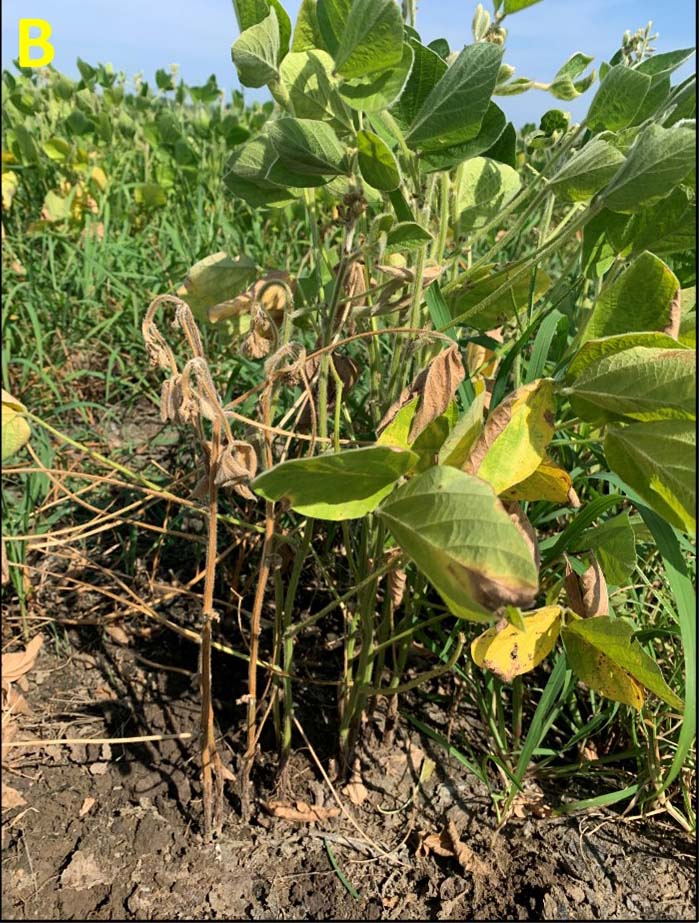Soybean Disease Update
Soybean fields in Oklahoma are suffering from the high temperatures and lack of rainfall experienced in the state in the last weeks. I have observed many fields with herbicide injury symptoms often mistaken for disease-related problems. Besides the herbicide injury, few plant diseases have been observed, and the fields look very clean. However, scouting the fields regularly is the key to identifying problems early on, and it’s essential to guide management decisions based on the goal of keeping the crops healthy and economic feasibility.
Considering the current extreme weather conditions currently experienced in the state, soybean growers need to pay attention to diseases favored by drought stresses, such as Charcoal rot. This disease was already observed in a soybean field in Mayes County on August 01st at very low incidence.
Charcoal rot: This disease is commonly observed throughout the soybean growing seasons in Oklahoma. The fungal pathogen that causes this disease, Macrophomina phaseolina, infects the plants early in the growing season; symptoms may not develop unless the infected plants are suffering from hot and dry conditions. The charcoal rot fungus survives in the soil, and the plant residue as very small, hard, black structures known as microsclerotia (Figure 1A). These tiny structures of the fungus survive on the soil, and it’s how the pathogen starts new infections in soybean plants in the following seasons. When soybean roots come into contact with the microsclerotia, the latter germinates and infects the soybean roots. Plants infected early in the season usually do not display symptoms until mid-season or later.
Symptoms of charcoal rot in the field include patches of plants showing reduced vigor,
yellowing, and wilting. The premature death of plants with the leaves still attached
is a common symptom of this disease. Another way to identify this disease in the field
is to look for the presence of microsclerotia in the lower stem and roots of the soybean
plants. The microsclerotia resembles a sprinkling of powdered charcoal in the diseased
tissue, hence the name charcoal rot. It’s important for growers to know that microsclerotia
are very small structures with less than 1/25 of an inch (1 mm). Internal stem discoloration
can also be observed.
Since this disease is associated with stressed plants, the incidence of charcoal rot can be reduced through proper fertilization, weed control, and irrigation. Like irrigation management, avoiding excessive seeding rates can help to reduce crop stress and minimize symptoms of yield loss to charcoal rot. Crop rotation with poor hosts, such as cotton or small grains, for one to two years, can help minimize yield loss due to charcoal rot. Although corn and sunflowers are hosts for the pathogen, research has shown that there are strains of the fungus that have host preferences. For instance, some strains prefer soybeans, while others prefer corn or sunflowers. Therefore, rotation with any other crop can be beneficial, and the longer the rotation, the better.
So far, complete resistance to charcoal rot in soybean cultivars is unavailable. However, partial resistance to this disease is available in cultivars adapted to southern climates (maturity groups IV and later). Please contact your local county extension office for current information.
Learn more about Charcoal rot in soybeans.
Figure 1: A) Microsclerotia produced by the charcoal rot fungus on the lower portion of a soybean
stem
B) Charcoal rot fungus microsclerotia in the internal part of the stem tissue.
Phytophthora root and stem rot: one disease that can be confused with charcoal rot and misdiagnosed in the soybean fields is Phytophthora root and stem rot. This disease was reported at low incidence in a soybean field in Wagoner County, Oklahoma, on August 01st. Although symptoms of this disease can be mistaken with charcoal rot, the development of Phytophthora stem and root rot is favored by soil temperatures above 60°F and high soil moisture levels. Wet, waterlogged, compacted soils are more prone to develop this disease. Symptoms of this disease generally occur during or shortly after waterlogged soil conditions.
The pathogen that causes this disease, Phytophthora sojae, can infect soybean plants at any growth stage, from seed to maturity. Symptoms observed in the early season include seed rot, pre-and postemergence seedling blight, and damping-off. However, no seedling disease symptoms were reported in Oklahoma in the 2023 growing season. However, on older plants, the symptoms of Phytophthora root and stem rot include the formation of dark-brown lesions on the lower stem that extends up from the taproot (Figure 2A). Leaves on older infected plants become chlorotic between the veins, followed by general wilting and death (Figure 2B).
Management of this disease includes the use of resistant varieties, crop rotation, soil drainage improvements, and seed treatment containing mefenoxam or metalaxyl. Please get in touch with your local county extension office for current information.
Figure 2: A) symptoms of Phytophthora root and stem rot. B) Plants showing symptoms of Phytophthora root and stem rot in the field, with plants completely dead.




